3 Lutyens war memorials definitely worth a visit
6-7 minute read
By Paul Nixon | November 8, 2022

Edwin Lutyens designed spectacular war memorials across Britain and the world. Paul Nixon has handpicked his personal favourites.
Edwin Lutyens was a prolific architect and evidence of his work can be seen in Commonwealth War Graves cemeteries overseas and in memorials throughout the United Kingdom.
My volume of Lutyens & The Great War (Francis Lincoln, 2008) reveals that he was involved in the design of 49 UK memorials, 9 overseas memorials and 135 cemeteries and memorials in France and Belgium.
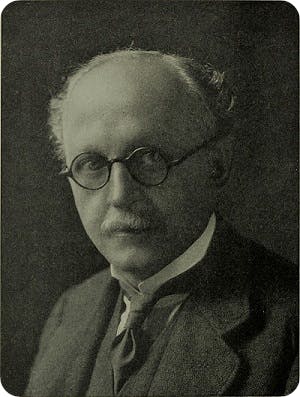
Edwin Landseer Lutyens (1869-1944).
In addition, Lutyens was also commissioned for eight private memorials, not to mention the two large fountains in Trafalgar Square, both of these designed by him to commemorate the First World War Admirals Beatty and Jellicoe. All of Lutyens' memorials are worth seeing if you get the chance. Here, I've chosen three that are particularly special to me.
1. The Cenotaph
Normally, at this time of year, I'd be looking forward to my annual pilgrimage to the Cenotaph in London. It’s shoulder-to-shoulder standing room only there, and in past years I’ve taken the first train out of my home town to get to Whitehall early enough to grab a space right in front of Edwin Lutyens’ iconic memorial. This year it’s going to be a rather different Remembrance Sunday with only a limited number of people permitted to attend the traditional 11 am service, and I expect that the same social distancing will be in evidence at Remembrance ceremonies worldwide.
11 November 2020 marks the 100th anniversary of the unveiling of the Cenotaph and the burial of the Unknown Warrior. A temporary cenotaph, made of wood, had been erected in time for the Victory Parade of 19 July 1919 and such was the public response to it that it was decided to erect a permanent version in Portland stone. The wooden original was taken down and pieces of it subsequently re-fashioned as cenotaph money boxes by blind ex-servicemen at St Dunstan’s. I have one of these in my collection at home, below.

In the years since the Cenotaph was erected, it appeared on millions of postcards. These days you’d be hard-pressed to find it in any Westminster souvenir shop. I’ve collected postcards of the Cenotaph over the years and it looks like it ceased to become a viable commercial proposition in the early 1980s. That’s a pity. In some ways, I am surprised, given the amount of airtime given to the numerous First World War centenary commemorations between 2014 and 2018 and, for that matter, the increasing public interest today in Second World War anniversaries.
This year already there has been considerable press coverage of 75th and 80th anniversaries for Dunkirk, D-Day, VE Day, VJ Day, The Battle of Britain and the Blitz – and we can expect more of the same until 2045.
Early photos of the Cenotaph are easily identifiable by the wreath pinned into place, the ribbons often pictured blowing in the wind.
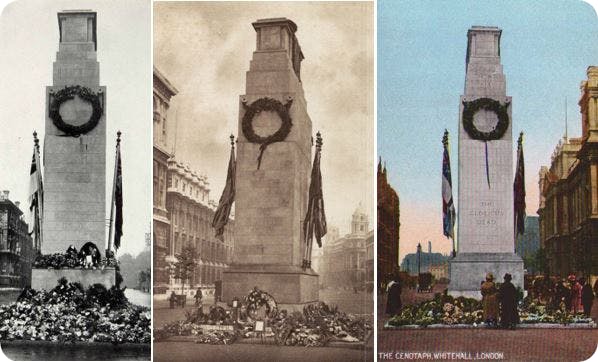
These pictures all to date to between 1919 and early 1920, before the permanent cenotaph was constructed.
The images below probably date to 1920 or 1921 and show the banks of flowers that were piled up against the Cenotaph. The image on the left can be easily obtained for a couple of pounds and must have been published in its hundreds of thousands. The image on the right is less common; it’s the same shot but with the policeman covered over by more flowers and the floral tribute in the right foreground removed.
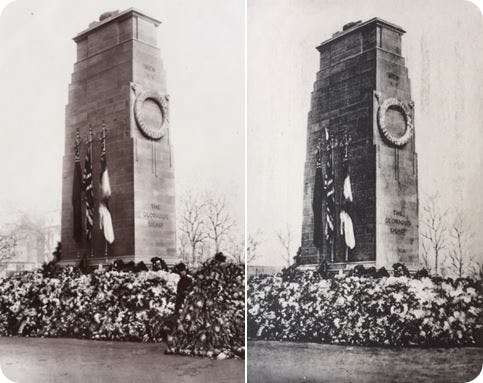
Fortunately, for fans of Lutyens work, there are examples of his memorials throughout England, from Morpeth and Holy Island in Northumberland to Hove in East Sussex.
2. Southend-on-Sea War Memorial
The memorial at the Clifftown Parade, Southend-on-Sea is probably the closest Lutyens memorial to where I live. It’s a nice example of a memorial featuring painted flags.
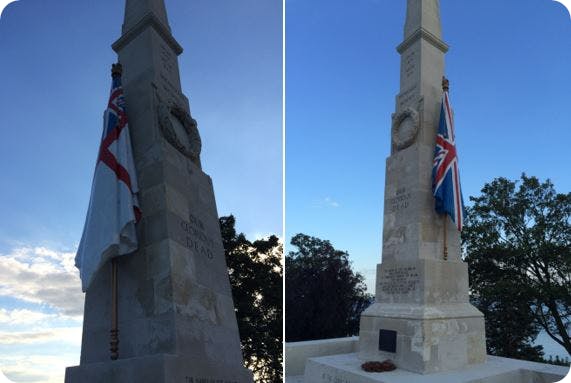
The Historic England website describes it as follows:
"“The memorial comprises a tapered obelisk, c11m tall, with a square base incorporating a moulded cornice set upon a square pedestal rising in six unequal sections. The lowest section is incorporated into low surrounding walls forming an enclosure, incorporating a flight of six broad steps, a platform and two further steps approaching the monument from the north. Bronze mounts for flags are fixed at either end of the surrounding wall.""
"“The north face of the base of the obelisk bears a carved stone laurel wreath. On either side, painted stone flags rise from the lower stage of the pedestal. The Union Flag flanks the west side and the White Ensign, the east. The inscriptions are carved into the north side of the memorial…”"
My photos, above, date to a visit from 2015, the text on the lower tier of the pedestal recording that;
"“The names of the 1,338 men of Southend-on-Sea in honoured memory of whom this memorial was erected by grateful residents are recorded upon a tablet placed in the refectory at Prittlewell Priory.”"
3. Thiepval Memorial
The most impressive Lutyens memorial is without a doubt, the Memorial to the Missing at Thiepval, on the Somme. Here, the names of 72,315 officers and men from the United Kingdom and South Africa have been etched into 48 panels on the memorial’s sixteen imposing piers.
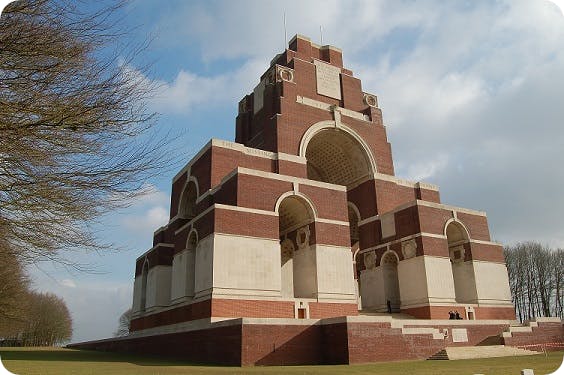
A visit to Thiepval should, in my opinion, be a part of every school curriculum; a reminder of the futility of war and a homage to those who made the supreme sacrifice. In recent years, a visitor centre has been opened at Thiepval and it is now easier than ever to learn more about the men who fought and died on the Somme. Every day that passes, more information about these men is being revealed and much of it has been published online.
One of the men commemorated on the Thiepval Memorial is Albert Alfred Wollen of the 4th Manchester Pals. He was 27 years old when he was killed in action on the 1 July 1916. I have three photos of Albert Wollen published on my own British Army Ancestors website and shown below. The one on the left is certainly the best. It almost certainly pre-dates the First World War, but as 12476 Pte A Wollen, Albert volunteered with the Manchester Regiment and served with 16 Platoon, D Company, 19th (4th City) Battalion, Manchester Regiment.

The photo in the middle is one of the 600 displayed on The Panel of the Missing at Thiepval and the third photo of Albert appears in the Manchester City Battalions Book of Honour. The men who appear in these photos are named, but it has always been a frustration that their positions in the photos are not identified. Nevertheless, I spotted Albert in the 16 Platoon photo, standing on the back row, sixth from left.
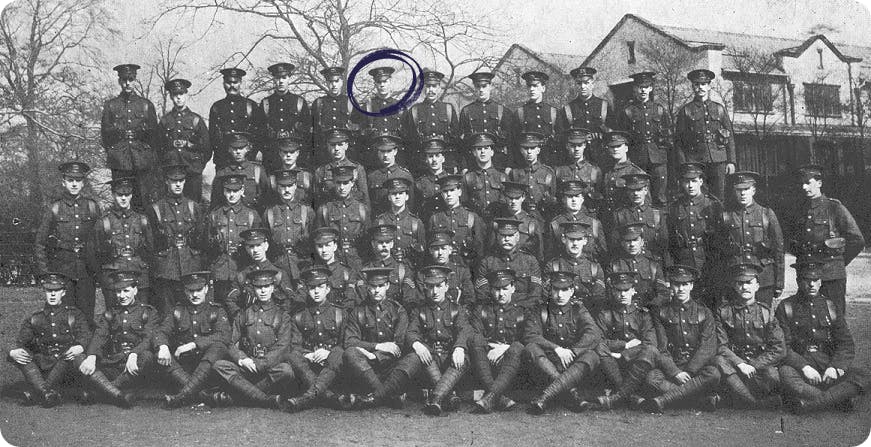
Findmypast has published all of the Manchester City Battalions photos. In addition to this record, on Findmypast you can also download Albert's medal index card, view additional information on Soldiers Died in the Great War, read about him in Lives of the First World War and view his Commonwealth War Graves Commission record.
A broad search for Albert Alfred Wollen on Findmypast quickly returns results from 1891, 1901 and 1911 census returns, his birth record and a death record for 1916. Twenty years ago you’d have had to search hard to find all of this information. Now it’s all there at the click of a mouse or swipe of the Findmypast app. All of these resources help to tell the story behind the name etched on Lutyens' memorial.
And what of Lutyens, the man whose architecture has left such an impression on landscapes worldwide? Born in 1869, the 10th of 13 children, he has been variously described as the greatest architect since Sir Christopher Wren and, by the late Gavin Stamp as;
""surely the greatest British architect of the 20th (or of any other) century.""
Lauded and rewarded during his lifetime, Edwin Lutyens died on New Year’s Day 1944 at the age of 74. Is there a Lutyens war memorial that's special to you? We'd love to hear all about it on Facebook, Instagram or Twitter.
Related articles recommended for you

Uncover Cornwall connections
What's New?
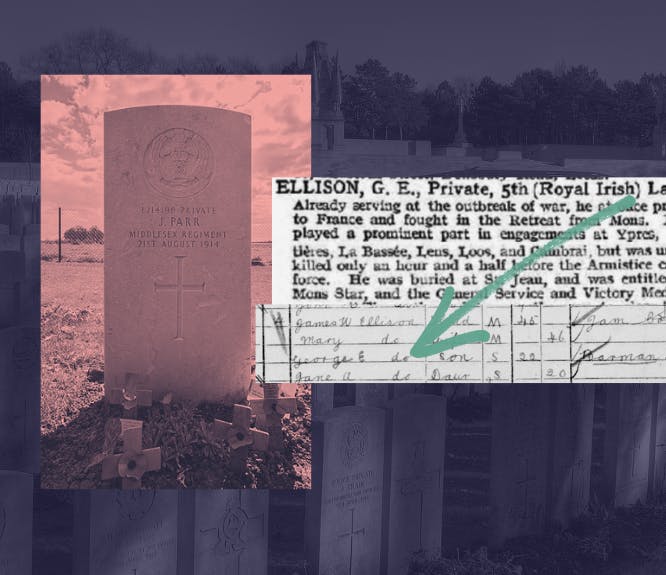
Remember their story: the first and last British soldiers killed in the First World War
History Hub

Who Do You Think You Are? Series 21: here's what you missed
Discoveries

